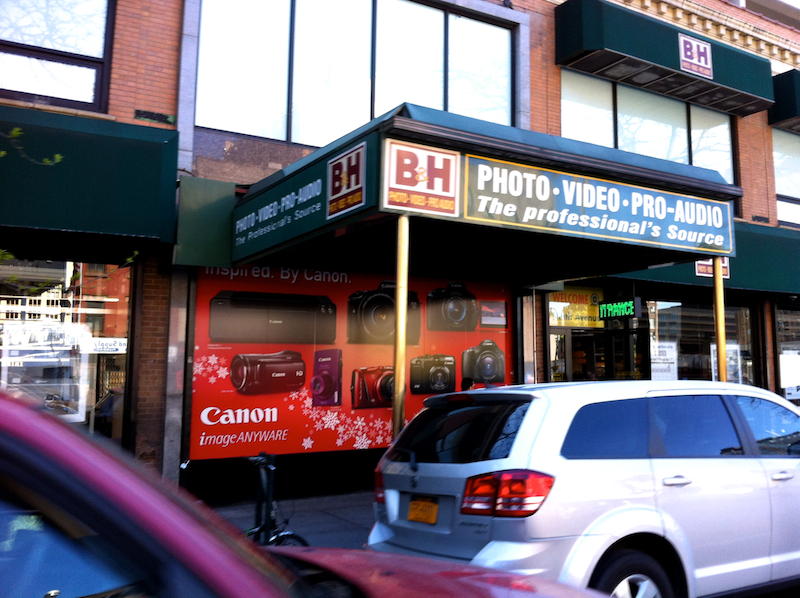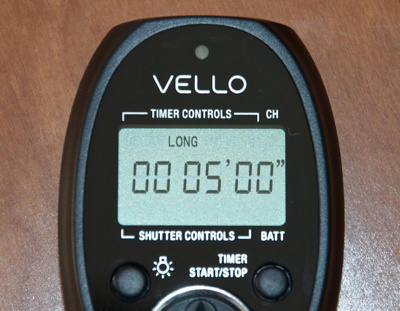VELLO WIRELESS SHUTTERBOSS TIMER REMOTE
Last updated: 22 April 2012
During a recent trip to New York City, I went the B&H SuperStore:

Wow, what a camera store! Three floors of cameras, accessories, and other photography gear, and even telescopes. Great customer support. The store was very crowded the Wednesday morning that I was there.
 I had been contemplating getting a programmable remote for my Nikon D7000 DSLR for use when doing long duration astrophotography. I have been using a Nikon Wireless Remote ML-L3 with my Nikon D7000 DSLR and previously with the D70 DSLR. For short exposures, the ML-L3 works great. But when doing exposures longer than 30 seconds with the D7000 DSLR, it is necessary to watch a clock for the length of the exposure. I have done up to 15 minutes this way while guiding with the 8" LX200-ACF. This works fine, but of course there is a better way and that is by using a programmable remote for the camera. While at B&H, I decided to purchase the Vello Wireless ShutterBoss Timer Remote, as seen on the right.
I had been contemplating getting a programmable remote for my Nikon D7000 DSLR for use when doing long duration astrophotography. I have been using a Nikon Wireless Remote ML-L3 with my Nikon D7000 DSLR and previously with the D70 DSLR. For short exposures, the ML-L3 works great. But when doing exposures longer than 30 seconds with the D7000 DSLR, it is necessary to watch a clock for the length of the exposure. I have done up to 15 minutes this way while guiding with the 8" LX200-ACF. This works fine, but of course there is a better way and that is by using a programmable remote for the camera. While at B&H, I decided to purchase the Vello Wireless ShutterBoss Timer Remote, as seen on the right.
The ShutterBoss wireless remote comes with a transmitter, a receiver, and a coiled cable (right to left):

The ShutterBoss is available in two models: wired ($52.50) and wireless ($99.50). The wireless model can also be used as a wired remote. When you purchase the ShutterBoss, you get a coiled cable that connects to your model camera. If you have additional cameras or purchase a new camera of a different model in the future, you only need to purchase a new cable for that model. A complete list of supported cameras is available on the B&H web site and on the Vello web site. The remote has a range of 250 feet; obviously more than enough for use at the telescope, but great for group photos when you want to get in the image. The remote can be programmed to use one of 100 radio channels and if you have multiple remotes (typically in a studio setting), you can program multiple receivers to be used with one transmitter. The remote has many very useful functions to control the camera, including single and multiple timed and delayed exposures, and programmable exposure lengths (with the camera's "Bulb" setting) from 1 second to 99 hours 59 minutes 59 seconds. Both the transmitter and receiver are battery powered (with batteries supplied in the box). The receiver has an ON/OFF switch, but the transmitter auto powers off when not used and powers on at the touch of any button. The manual says the transmitter batteries should last for 4 years and the receiver battery 400 hours (in standby mode). The receiver can be mounted on a camera flash hot shoe, or on a tripod or accessory bracket (including a camera piggyback adapter) using the built-in 1/4"-20 threaded hole on the bottom of the receiver.
For astrophotography, the long exposure capability is the primary function for which I'll use the remote. I can set an exposure length on the remote to 1, 2, 3, 5, 10, or 15 minutes (or any other duration). Here is the remote showing a 5 minute exposure setting:

During a single exposure with the Bulb setting, a timer shows the running length of the exposure. So, if you want to watch the display, you don't have to program the remote for a specific exposure length. When the desired exposure duration is reached, just press the remote shutter release button again to stop the exposure. If you want to take multiple 1 minute exposures, such as for stacking, you can program the remote take to up to 99 photos. You can also program the delay between the exposures from 1 to 59 seconds. A more advanced mode allows delays up to 99 hours 59 minutes 59 seconds.
I have just begun to use the ShutterBoss for astrophotography. Here is a photo showing the ShutterBoss receiver mounted on the D7000 DSLR hot shoe and on a piggyback adapter. The camera is mounted on the Off-Axis Guider on my 8" LX200-ACF:


I am not yet certain which will be my preferred location for the receiver.
So, how well did the ShutterBoss perform when doing astrophotography with my Nikon D7000 DSLR? Extremely well.
The transmitter light is not too bright for night use, as seen here in this brightened image:

The light is turned on with a small button on the transmitter handset and turns off automatically after about 5 seconds. That is long enough when making settings. However, when using the Bulb mode you either have to keep pressing the light button or shine a red flashlight at the display to monitor the exposure duration. I used the flashlight to see the display during exposures when using the Bulb mode. The receiver has a bright green LED that flashes when an exposure is not in progress. During an exposure controlled by the ShutterBoss, the LED is a steady red. Since I found the flashing green LED annoyingly bright, I have covered it with a small piece of red lens tape. The transmitter handset has a red LED that flashes during an exposure; not a problem for night vision.
The remote does not remember the last used mode. You have to keep selecting Bulb or Timer mode for long exposures. It does remember the values entered for exposure length, number of exposures, and delay between exposures. There is no lanyard attachment point on the transmitter handset; wish there was. However, the handset is lightweight and comfortable to hold, so not being able to use a lanyard is not a big problem. And you can put the handset in a pocket since the remote is a radio and not IR device. The ShutterBoss can still control your camera from inside a pocket. There is no supplied case, but I have an old electric shaver leather case that works nicely to hold all the components.
My camera has a mirror lock-up function, so I set the camera to that mode. During astrophotography, I use three modes of the ShutterBoss:
"Single Shot" mode is used for making short exposures. Focus tests and bright object imaging are done in this mode. I set the camera to use a 1 second exposure. Before I start the exposure I press the remote shutter release button to lock the mirror up. To take the exposure, I press the remote shutter release button a second time. The camera exposure setting controls the length of the exposure.
"Bulb" mode is used for making long exposures, typically image framing test exposures. These exposures are normally 1 minute in length. The camera is set to "Bulb" mode as well. I use this mode instead of a programmed mode so that I don't have to keep changing the programmed exposure length. The first press of the remote shutter release button locks up the mirror; the second starts the exposure. I monitor the handset display which shows the length of the exposure in HH:MM:SS. When the desired exposure length is reached, the remote shutter release button is pressed and the exposure is ended and the mirror returns to the normal position.
"Long" mode is used for making longer exposures, usually deep sky objects. These exposures are usually 5, 10, or 15 minutes in length. The camera is set to "Bulb" mode. The exposure length is set on the LONG display. When ready to begin the imaging, a press of the remote shutter release button locks up the mirror. The exposure is started by pressing the Timer Start/Stop button on the ShutterBoss remote handset. I can monitor the handset display which shows a countdown of the remaining time for the exposure in HH:MM:SS. But I don't monitor it since my eye is at the illuminated reticle eyepiece so that I can make manual guiding corrections and the handset is usally in a pocket at this point. When the programmed exposure length time is reached, the remote tells the camera to close the shutter. The mirror returns to the normal position. No more clock watching.
So far, I've only had a brief chance to use the Vello Wireless ShutterBoss Timer Remote for astrophotography. I have quickly come to appreciate using it. The Nikon Wireless Remote uses IR and so is sensitive to obstructions in the line-of-sight. No such limitation with the ShutterBoss. The ShutterBoss seems very responsive when starting and stopping exposures, either manually or when doing a programmed exposure. Using it won't make digital camera astrophotography any easier, but it does simplify the taking of the images. Unfortunately, the ShutterBoss can not be used when doing video recording with the D7000 DSLR. That's probably due to the design of the D7000, which uses a separate button to start/stop video recordings in "Live View", and not the fault of the ShutterBoss. If you don't use a remote with your digital camera, you have to worry about enducing vibrations when touching the camera to start/stop the exposures. With a remote, this problem goes away. The Vello ShutterBoss gives you lots of exposure control options, as well as being useful for many types of photography, not just astrophotography. I definitely look forward to using the ShutterBoss for all my (non-video) D7000 DSLR astrophotography and will use it for other purposes as well. Definitely a recommended accessory.
Go to the ETX site
Go to the Cassiopeia Observatory site
Copyright ©2012, 2018 Michael L. Weasner / mweasner@me.com
URL = http://www.weasner.com/co/Reviews/2012/Vello_ShutterBoss/index.html
